2024 Toyota Tundra TRD Pro Begs For Your Attention

Toyota has been on a roll lately. With models like the redesigned 4Runner, Tacoma and Land Cruiser, if you’re an off-road enthusiast and a Toyota fan you should be in heaven right now. If you don’t wanna pay markup or wait on more hardcore versions of the new models to launch, you can indulge your off-road needs with the existing Tundra TRD Pro. You’re just going to need some deep pockets and prepare to look like a bro wherever you go.
Toyota Unveils The Sixth Generation 4Runner
Full disclosure: Toyota lent me a Tundra TRD Pro for a week with a full tank of gas, and I managed to get it a lil dirty playing in some fields.
Photo: Lawrence Hodge/Jalopnik
The current Tundra debuted in 2021 for the 2022 model year, which was also the last time we drove it. The Tundra’s first redesign since 2007, the current generation has a more bold and commanding presence, and the TRD Pro ups that to 11. Maybe even 20. The first thing you notice is how massive it is — nearly 20 feet long and seven feet wide, you dwarf most vehicles on the road.
Equally massive is the TRD Pro’s price tag. With trims like this, most people know you have to pay to play. The TRD Pro’s starting price of $72,130 is positioned above the Tundra 1794 Edition and below the $80k-plus range-topping Tundra Capstone. With very few options (just $295 worth) my tester rang in at $74,295. This more or less lines up with other off-road competitors at this price point like the GMC Sierra 1500 AT4 (starts at $68,395), Ram 1500 RHO ($71,990) and Chevy Silverado 1500 ZR2 ($71,895).
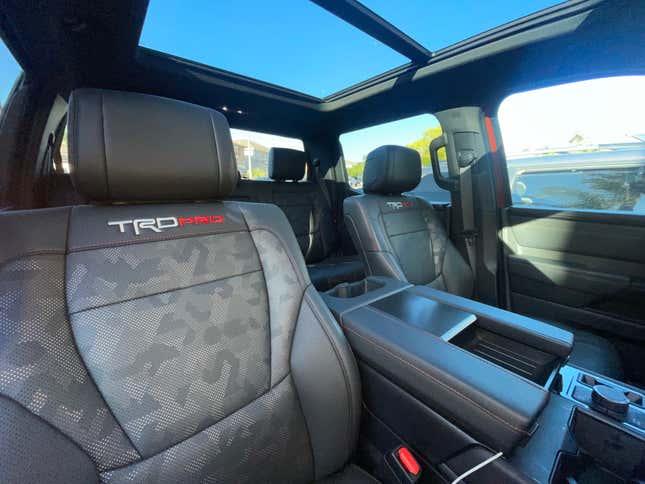
Photo: Lawrence Hodge/Jalopnik
Beyond just the size, the Tundra TRD Pro comes off as a bit obnoxious. It’s a brodozer for sure, with a massive front grille, 18-inch BBS wheels wrapped in 285/65R18 Falken Wildpeak all-terrain tires, and a constant reminder that you’re driving a TRD. There’s no fewer than 11 TRD or TRD Pro badges on the exterior. That includes each wheel, the aluminum skid plate, visible suspension components, the rear tailgate and fake hood vents.
There’s five more in the interior: the engine start button, each front seat, the shifter and steering wheel. The lid on top of this bro-y energy drink are the camo print accents. Toyota calls it “technical camo,” and the fender flares, tailgate spoiler and seat patterns are covered in it. Anyone under 20 years of age might think it’s cool. A grown man like me thinks it’s all way too much.
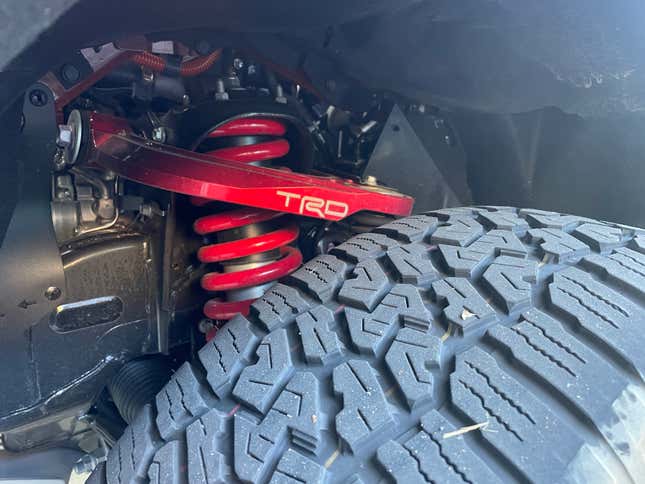
Photo: Lawrence Hodge/Jalopnik
It is sure-footed and capable when the terrain gets tough, at least. An electronically locking rear differential helps increase grip to the rear wheels, and the TRD off-road suspension setup with 2.5-inch-diameter Fox internal bypass shocks means you could probably take a light jump in this thing. All is helped by Toyota’s Multi-Terrain Select system with mud, sand, and rock modes. The TRD Pro is not quite Moab ready, however.
There’s an aluminum skid plate, but it only protects the engine and drive components at the front end of the truck. There’s a small steel skid plate over the transfer case, and another plastic one covers the fuel tank, so things may get a bit dicey. Places like the fuel tank, oil pan and transmission are some of the most vulnerable places on an off-road vehicle, and equipping a truck that’s billed as being this capable with a “plate” that can be punctured over a vital area of the underbody is a weird miss.
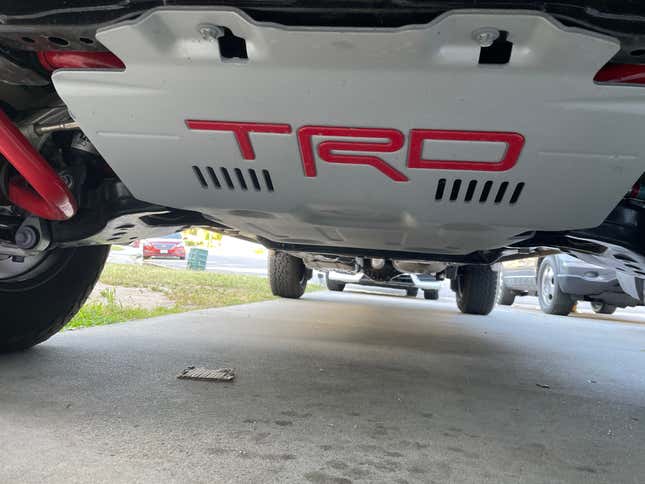
Photo: Lawrence Hodge/Jalopnik
Despite that, the TRD Pro shines in other situations. I took the truck on an unpaved local road that looked like something straight out of the late 19th century. The TRD Pro handled grooves and ruts with ease, the Fox shocks soaking up the bumps and imperfections with hardly a shutter in the cabin. Problems came when getting to deeper stuff. In attempting to traverse a ditch to reach a sandy area that local ATV riders use, I discovered that the Tundra’s back end will bottom out hard enough that you’ll hear an unsettling slam in some situations. The issue is the rather low departure and approach angles of 24.2 and 26.2, respectively.
The driver-assistance features are also strangely sensitive when off-roading. The Tundra’s myriad safety systems can annoyingly kill the fun, as they freak out in random conditions. Things like bushes and trees will either cause the parking sensors to blare at you or fully activate automated emergency braking. It’s weird that, when off-road modes are engaged, Toyota doesn’t program the safety tech to disable. The features can be disabled manually, but it requires digging into menus to do so.
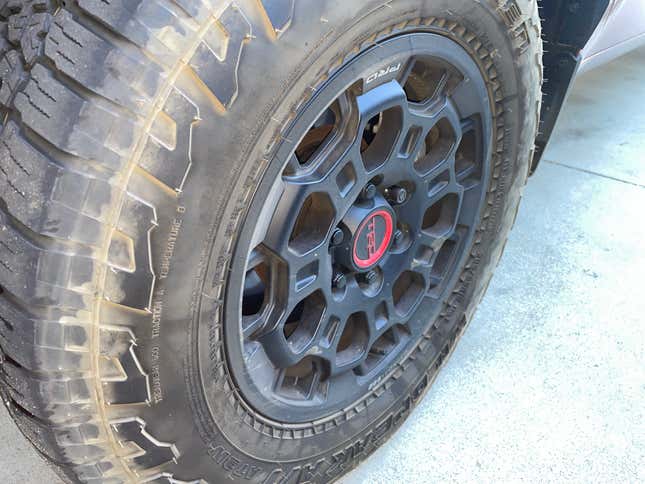
Photo: Lawrence Hodge/Jalopnik
The Falken Wildpeak all-terrain tires do a good job of helping with traction off-road. On the road, however, they fall flat. There were a few times where the Tundra’s handling felt uneasy at freeway speeds, almost like the tires were slightly greasy.
Standard on the TRD Pro is Toyota’s i-Force Max powertrain, which pairs a twin-turbo 3.4-liter V6 with a hybrid setup for a total of 437 horsepower and 583 pound-feet of torque. Mated with a 10-speed automatic transmission, Toyota says this engine should get 22 mpg combined; the EPA rates the TRD Pro at 18 mpg city, 20 mpg highway and 19 mpg combined. I never came close to those numbers, averaging just under 15 mpg in mostly city driving in normal conditions. Granted, this is a 6,015-pound pickup truck, so I wasn’t trying to drive it like a sports car. The Tundra’s inefficiency led me to wonder what the point of the hybrid system was. Extra power? Bragging rights? Whatever it is, it’s not fuel economy.
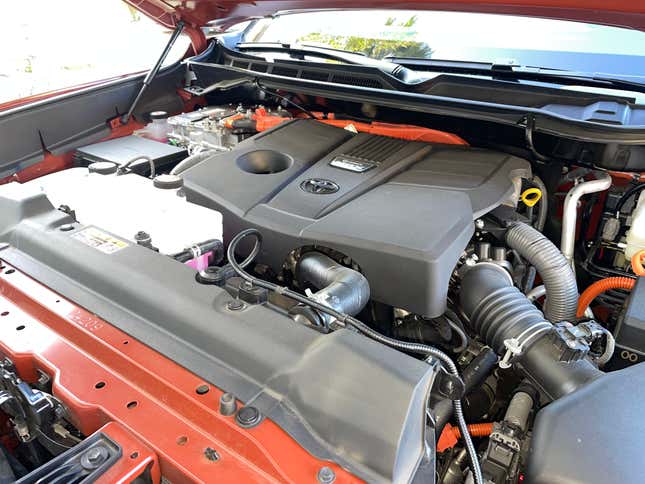
Image: Lawrence Hodge/Jalopnik
Another downside is the interior. It’s roomy and feels airy thanks to the standard panoramic roof. It’s also filled with all the tech and features you’d expect in a vehicle at this price. There’s a massive 12.3-inch center gauge cluster for the driver that has great resolution, an even bigger 14-inch infotainment screen that controls everything else, excellent heated and cooled front seats, and dual-zone automatic climate control.
The problem is quality. Many surfaces and pieces of switchgear both look and feel cheap, unacceptable given both the TRD Pro’s price and Toyota’s history of quality control. Black plastic of varying thickness is everywhere. Big, flat switches that control things like trailering mode, center diff lock and the hazard lights feel as if they’ll snap off if pressed too hard. The interior door handles felt as if they were made from a single piece of hollow plastic. Even the gearshift, which annoyingly had a cover that slightly moved up and down, felt as if it could easily be pulled off.
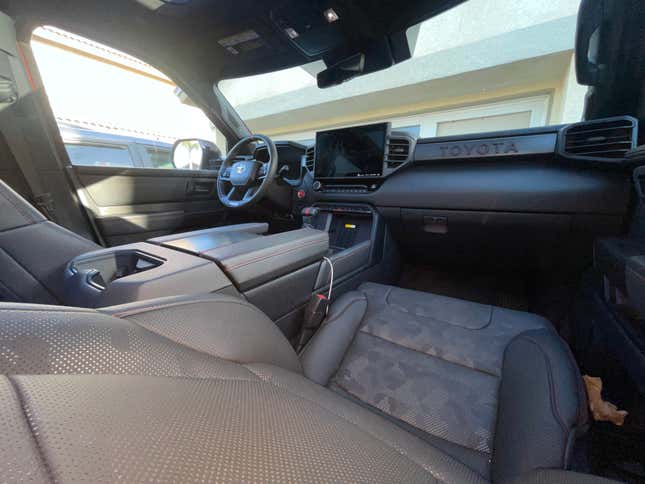
Photo: Lawrence Hodge/Jalopnik
Ultimately, the Tundra TRD Pro comes across as a solid effort that’s just trying a bit too hard to prove to everyone how capable it is instead of putting that energy into actual capability. Despite its looks and off-road tech, the TRD Pro is more for someone who’s going to drive this thing to work during the week and every once in a while take it off the beaten path that’s a bit more rough than what your average crossover can handle. For some buyers, the Tundra TRD Pro will be the perfect truck. For others, it’ll need just a bit more.





